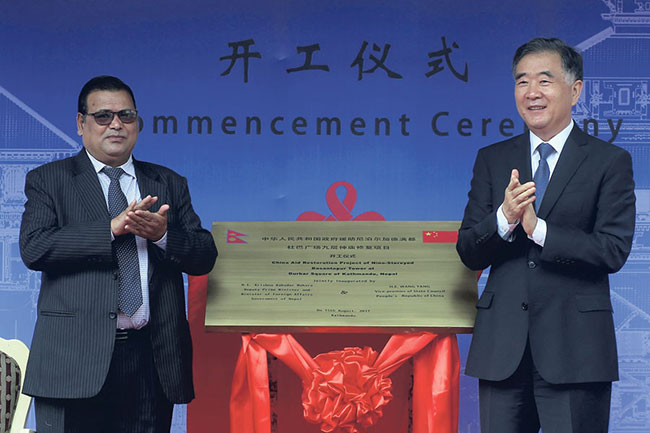Chinese experts have already warned that India could cite security concerns to derail BRI projects in Nepal
When tensions erupted between China and India over Doklam, the issue raised alarm bells in Nepal, which has always been a key area of intense Sino-Indian rivalry. But when Indian Foreign Secretary S Jaishankar was asked whether the issue had featured in the recent Deuba-Modi talks, he flatly rejected the insinuation. But it is unlikely that the two prime ministers did not talk about what was described as perhaps the most serious impasse between the two rising superpowers since they fought a war in 1962.
Rather, the issue could have been one of the major agendas of the talk given that Nepal had chosen to remain neutral, much to India’s dismay. New Delhi was already fuming over many of Nepal’s recent foreign policy decisions like military exercise between Nepal Army and Chinese PLA, which was followed by the decision of the then government of Pushpa Kamal Dahal to sign the Belt and Road Initiative (BRI) framework.
NC to join Karnali Province govt


If that wasn’t enough, just a week after Foreign Minister Krishna Bahadur Mahara announced Nepal’s neutral position in the Doklam stand-off, it laid out red carpet to Chinese Vice-Premier Wang Yang. The interesting series of events pointed to one thing: Nepal trying to assert its independence in foreign policy and its unwillingness to throw in its lot with the region’s Big Brother. History has shown that such endeavors have cost Nepal dearly.
Unpleasant record
Hard stand on India have caused the failure of many governments in Nepal. In the late 1980s, King Birendra imported some arms from China, breaking Nepal’s traditional dependence on India. In response, Prime Minister Rajiv Gandhi imposed an economic blockade that lasted for over a year. The resultant economic hardships fueled India-backed pro-democracy movement that culminated in stripping monarch of his executive powers and reducing him to a ceremonial head of state. When Birendra’s successor, Gyanendra, retook executive powers in 2005 and followed it up with a diplomatic move to get China on board of SAARC, he again earned the ire of the group’s biggest and powerful member, India.
Four of the eight member states of SAARC signed the BRI framework when they had ‘pro-India’ governments.
History was repeated in 2006 as a furious New Delhi backed opposition parties’ anti-king protests that culminated this time around not only in the curtailing of royal powers but in the abolition of the 240-year old monarchy itself. As recent as last year, when a coalition government led by Prime Minister KP Oli signed a number of treaties including the one that sought to end the land-locked Nepal’s traditional dependence on India for access to sea, by arranging for an alternative transit route through China, his government fell within months.
Changing tides
In all these events, China acted almost as a mute spectator. China’s age-old Nepal policy is aptly explained by John Garver in his 2001 book Protracted Contest: Sino Indian Rivalry in the Twentieth Century: “Chinese leaders have understood that Chinese interests are best served by encouraging and supporting Nepali independence from Indian domination but not pushing so hard as to rouse Nepali suspicions of China”. There is no doubt that Garver’s words held truth until sometime back. But as it takes more assertive postures in global politics, China’s interests have in recent years expanded beyond its Tibetan concerns, and it has come to play an increasingly bigger role in South Asia, especially in Nepal. In this context, will Nepal’s recent foreign policy decisions invite the wrath of India? Maybe not.
While internally accepting that Nepal falls under New Delhi’s sphere of influence, Beijing is moving aggressively forward. Since 2014 China has overtaken India in Foreign Direct Investment (FDI) in Nepal. Earlier this year, China pledged US $8.2 billion in FDI as compared to $317 million by India. Although just a symbolic move, the Chinese decision to export fuel to Nepal in the wake of the ‘economic blockade’ was also significant, in addition to the joint military exercise a year later.
This changed power equation might make India react to Nepal cozying up to China differently to the way it did before. Four of the eight member states of SAARC signed the BRI framework when they had ‘pro-India’ governments. With Nepal joining the likes of Bangladesh, Sri Lanka, Afghanistan and Pakistan in the mega-Chinese infrastructure project, the dominant SAARC member, India, was isolated. Political leaderships in many of these countries are already tilting towards Beijing. Had India tried to keep these countries from embracing BRI, it would have been counter-productive for India, as they would have done so any way, signaling a loss of Indian power in the region.
Most notably, Chinese vice-premier Wang Yang’s visit to Kathmandu amid the Doklam standoff was an indication of Beijing’s changing Nepal policy. Earlier, a visit by high level Chinese dignitary at such a crucial juncture would have been rare. While New Delhi was definitely not happy about this, it also found its hands tied for it can no longer afford to react harshly to Nepal’s decisions.
The tight rope
India is unlikely to feel comfortable with China’s growing presence and influence in its traditional ‘sphere of influence’. Chinese experts have already warned that India could cite certain security issues as an excuse to derail BRI projects in Nepal. Such moves could invite more turmoil for Nepal. Is Nepal capable of a fine balancing act between India and China as the old geopolitical game takes an uncertain turn?
The author is a Political Science graduate from Delhi University

































